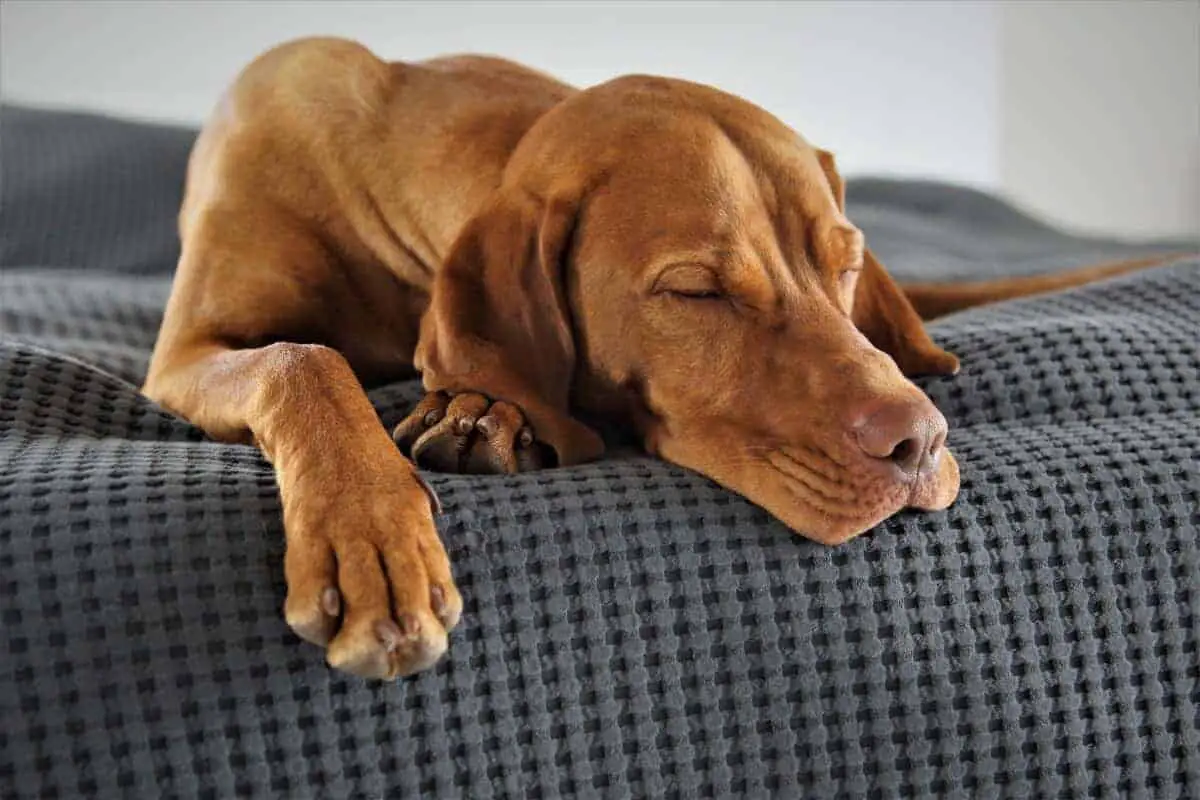A collar is something that most dogs will wear at some point during their life, it gives owners a sense of security and an identity for their dog. Dogs will often wear collars for most of the day and this leaves the question, should you take your dog’s collar off at night?
It is recommended to take your dog’s collar off at night. The main reason for this is the danger of being caught up on something in their bed, or around the home, leading to choking. For this reason, removing your dog’s collar at night can both prevent harm and allow them to have a restful sleep.
There is no common reason why dogs should wear a collar all the time. Most dogs will only spend part of their day away from home and the main point of wearing a collar is solely to identify them or attach a leash. Here we discuss reasons for removing your dog’s collar at night and highlight why you may want to extend this to the daytime too.
Contents
Reasons To Take Your Dog’s Collar Off At Night
Safety
First and foremost, safety is important, and the main reason for removing your dog’s collar at night. Predominantly nighttime is where your dog will be left alone either in a crate or to roam around the house. The number of deaths caused by strangulation of the collar reaches into the thousands per year according to many resources, including PetSafe and The American Pet Products Association. The scenario often referenced, is during the time spent in their crate, where their collar gets caught on the wire cage and chokes the dog.
Not only should you remove your dog’s collar at night, but it is also advisable to remove it when you are out of the house. Not only should you be thinking about the dangers that may befoul your dog during the night, but you should also be thinking about any point when your dog is left alone.
The best advice would be to remove your dog’s collar at any time you are not present. Commonly there is no real need to have your dog’s collar on all the time. The safety of your own home is the best opportunity to remove your dog’s collar.
One angle to take is to assess the surroundings in which you are leaving your dog, are they safe? As well as assessing the environment there are specialist collars you can get which are designed to reduce the chance of strangulation via your dog’s collar. These collars are designed with a break-away link which you attach when not walking them. As soon as any tension is applied to the collar it will break-away and fall off. If you decide to walk your dog, there are two D rings in which you attach to a leash, this allows you to walk your dog without the collar breaking off. These collars are designed by Petsafe and are sold in many places including Amazon.
Skin Irritation
This can often be a problem with sensitive dogs or dogs that tend to get very wet and muddy. Collars are great at slipping themselves down past a dog’s fur and onto their skin. This will in some cases start to present problems for chafing, leading to skin irritation and sores. Another great reason why dogs should not wear collars all the time and especially during the night.
Chafing and skin irritation can happen due to prolonged periods of time wearing a collar. If your dog has been somewhere muddy, dirt and bacteria can get underneath the collar, causing possible skin irritation. Most of the time this is nothing to worry about, however, check with your vet as soon as possible.
Comfort
Although safety is the most important reason for removing your dog’s collar, there are a few other reasons your dog shouldn’t wear its collar all the time.
Comfort is one reason and although it may not seem important any little improvement to your dog’s life is one every loving owner will want to make. The night is when dogs tend to sleep, although it may seem they extend this period of time throughout the day……lucky pooch. Comfort must be something your dog needs when choosing to rest his head and a collar won’t make that experienced any more pleasant. Whether your dog seems bothered about having their collar on when sleeping, removing it is a good way to ensure that it does feel uncomfortable for them.
Appearance
This may seem superficial, but it’s something every owner loves to think…I have the best-looking dog. If this sounds like you, it may be time to remove your dog’s collar as much as possible. When dogs wear collars for long periods of time, their fur can start to become messy around the neck.
Dog collars go through a fair bit of movement and slowly but surely they make their way through the fur, causing it to bunch up either side. Just like having your head out a car window, the hairs start to stick in this position, as soon as the collar is removed their hair stays on either side. Even after brushing the hair back into the position it still appears a bit strange around the neck area.
Additionally, many collars can cause your dog’s fur to turn the collar of the collar, this is the dye coming out of the collar and can often cause alarm if you have a red collar. Dogs that go in and out of the water will often be the victims of color running, but after a few washes, the collar should stop causing fur discoloration.
So there are benefits beyond safety that can be had for those that remove their dog collars when possible. After all, they are mainly for identification and control.

Do Dogs Like Collars
Dogs will react differently to their collars depending on the context in which they are presented. If your dog is aware that they may be going for a walk your dog will react excitedly to their collar and if you have caught them digging in the garden and attach their collar to enable control they may act disheveled. In most cases where there is no obvious context, dogs will have no reaction towards their collar and present neither like nor dislike towards them.
Past experience will often play a vital role in whether your dog likes or dislikes its collar. If you are an owner who does not make your dog wear their collar at home, they will associate their collar with a walk. The use of shock collars or any other collar that provokes an unwanted feeling for the dog will inevitably cause them to associate their collar with a negative experience. Sometimes stray dogs will react negatively towards their collar as the ability dogs have to remember experiences is so profound. Past neglect could have been in the form of aggressive restraints, poor training techniques, and collars that cause pain.
Do Dogs Like It When You Take their Collars Off
Although dogs will commonly have no reaction to having their collar taken off, in some cases, they may learn to enjoy it. If you have taken your dog for a walk and have arrived home to relax, making a point of taking your dog’s collar off every time you arrive back will teach your dog that it’s now time to rest.
What Age Should a Puppy Wear a Collar
Puppies should not need to wear their collar until they are able to go out in public. This will be when they are fully vaccinated at around 12 weeks old.
Although you will have to wait until your puppy is fully vaccinated to take them out for a walk, there is no reason why you cannot introduce your puppy to a collar. I would recommend taking them out in the garden with a collar and lead to help them get used to this way of walking. Vets tend to be ok with puppies going outside in the garden, there are just a few things you should be aware of, check this article on “When Can a Puppy Go Outside In The Garden” for more details.
Puppies can also be extremely curious when exploring and it is important that you keep an eye on them at all times when they are out in the garden. Collars can easily get stuck around places your pup is trying to explore. Despite this possible danger if your puppy escapes then at least people will have a way of identifying them if they do get lost. I wrote an article on “How to Puppy Proof Your Garden”, which should offer some insight on how to secure your outside area in anticipation of a new puppy.

Transitioning Your Dog Out Of A Crate
The number one danger that was highlighted above is the chance that your dog will snag their collar on the inside of their crate during the night. As this usually happens on metal crates, it could be a good idea to switch to a fabric-type crate or transition completely to an open bed.
The transitioning period will often happen when your puppy reaches an age where they are well trained enough to behave around the house and their toilet training is complete. In most cases, your dog will be pleased to transition out of its crate. This is a big step for them and also for you as an owner, I would suggest isolating them to one room during the night until the time comes to allow them more free space. Be sure to prepare the room for them, ensuring there are no dangerous objects or situations they could get into whilst you are not there.
As an extra precaution, you can purchase a camera that will be linked to your phone. At any point during the night, you can check them and in some cases record them to see what they got up to while you were asleep. This can be a great way of identifying any dangers or mischievous activities they may get themselves into. there are all sorts of different standards of a camera and you can pay lots or little depending on, quality, features, and various other things, just remember all you want to do is see them during the night.
Don’t let these issues tear you away from using a crate, metal ones are preferably used whilst traveling in a car with your dog. Although harder to pack and unpack, metal crates have the advantage of being more sturdy and therefore could bring about some protection for your pooch. Of there are many additional things to think about when traveling with a dog. If you want to learn more about the best ways to travel with your pooch and discover what transport options you have available for your dog, check out our article on how to travel with a dog.
Conclusion
In conclusion, taking your dog’s collar off at night is something I would strongly advise you to do and maybe look into removing it altogether when your dog is at home. Hopefully, you enjoyed this post and if you are looking for more great articles on getting out and about with your dog, check out our homepage.

